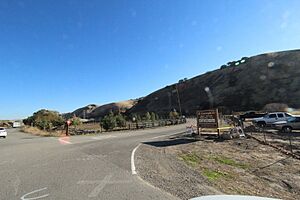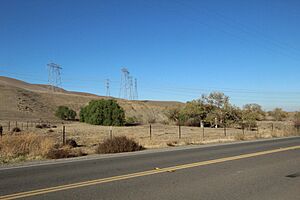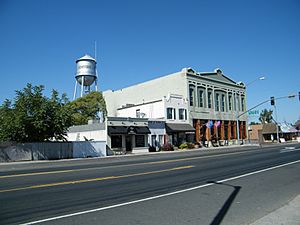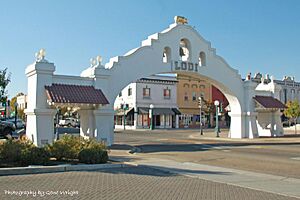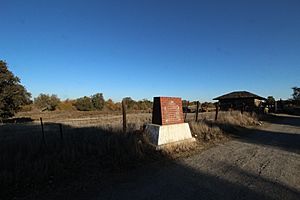California Historical Landmarks in San Joaquin County facts for kids
Do you know that California has special places called "Historical Landmarks"? These are spots where important things happened or where famous people lived. They help us remember the past and learn about how our state grew.
San Joaquin County, California is full of these amazing historical landmarks! From old battlefields to places where important inventions were made, each spot tells a unique story. Let's explore some of these cool places and discover the history hidden right in your own county!
Contents
- Discovering San Joaquin County's History
- The Battle of Stanislaus
- Benson's Ferry: A River Crossing
- The Burial Place of Juan Flaco
- Carnegie: A Coal Mining Town
- Corral Hollow: A Path Through the Mountains
- French Camp: An Early Trading Post
- Lockeford: A Historic Town
- Lodi Arch: A Welcoming Landmark
- Lone Star Mill: An Old Grist Mill
- Mokelumne City: A Ghost Town's Past
- New Hope: An Early Agricultural Project
- San Joaquin City: A River Port
- First Transcontinental Railroad Completion Site
- Stockton Assembly Center: A Difficult Time
- Stockton Gurdwara Sahib: A Place of Worship
- Temple Israel Cemetery: A Historic Burial Ground
- Weber Point: Stockton's Waterfront History
- Woodbridge: A Historic Town and Bridge
- Images for kids
Discovering San Joaquin County's History
The Battle of Stanislaus
Imagine a time when California was still wild and new. In 1826, a big event happened at the meeting point of the San Joaquin River and the Stanislaus River. This was the site of the Battle of Stanislaus. It was an important moment in the early history of the area. This landmark, number 214, marks a place where different groups met, sometimes in conflict, as California was being settled.
Benson's Ferry: A River Crossing
Long ago, before many bridges were built, people used ferries to cross rivers. Benson's Ferry (Landmark 149) was one of these important crossings. Located on the North Fork of the Mokelumne River near Thornton, this ferry helped people and goods move across the water. It was a vital link for travel and trade in early California.
The Burial Place of Juan Flaco
Have you ever heard of a hero who rode a horse for miles to deliver an important message? That's the story of John Brown, also known as Juan Flaco (Landmark 513). During a time of conflict in California, Juan Flaco rode incredibly fast from Los Angeles to San Francisco. He carried news that helped save lives. He is buried in Stockton at 1100 E Weber St. His grave reminds us of his bravery and speed.
Carnegie: A Coal Mining Town
Deep in the hills near Tracy was a town called Carnegie (Landmark 740). This wasn't just any town; it was a coal mining community! People came here to dig for coal, which was a very important fuel for trains and factories back then. Today, the area is part of the Carnegie State Vehicular Recreation Area. It's a reminder of the hard work that helped power California's growth.
Corral Hollow: A Path Through the Mountains
Corral Hollow (Landmark 755) is a historic pass through the hills near Tracy. For many years, this hollow was a key route for travelers and wagons. It connected different parts of California, making it easier to transport goods and for people to move around. It played a big role in the development of the region.
French Camp: An Early Trading Post
Before California was even a state, fur traders from Canada set up a camp near what is now French Camp. This camp, established in 1832, became known as French Camp (Landmark 668). It was an important trading post where different groups of people met and exchanged goods. This spot, located at Elm St at French Camp School, shows us how early settlers and traders shaped the area.
Lockeford: A Historic Town
The town of Lockeford (Landmark 365) is more than just a town; it's a historic district! This means that many of its buildings and streets have been preserved to show what life was like long ago. Lockeford was founded by Dr. Dean Jewett Locke in the 1850s. Walking through Lockeford is like taking a step back in time to see how communities were built in early California.
Lodi Arch: A Welcoming Landmark
When you visit Lodi, you might see a beautiful arch over the street. This is the Lodi Arch (Landmark 931), located at E. Pine & S. Sacramento Sts. Built in 1907, this arch has welcomed visitors to Lodi for over a hundred years. It's a symbol of the city and its long history, especially known for its vineyards and grape growing.
Lone Star Mill: An Old Grist Mill
Imagine a time when farmers needed a place to grind their grain into flour. The Lone Star Mill (Landmark 155) near Clements was one such place. Built in 1852, this mill was very important for the local farmers. It helped turn their crops into food, supporting the growing communities in San Joaquin County. Today, it's located at Stillman L. Magee Park.
Mokelumne City: A Ghost Town's Past
Once upon a time, there was a bustling town called Mokelumne City (Landmark 162) near Thornton. It was founded during the California Gold Rush and was a busy port on the Mokelumne River. However, floods and changing trade routes led to its decline. Today, it's mostly a ghost town, but its landmark reminds us of its lively past and how quickly fortunes could change in early California.
New Hope: An Early Agricultural Project
In the early days of California, people tried many ways to grow food and build communities. The New Hope Agricultural Project (Landmark 436) near Ripon was one of these efforts. It was an early attempt to create a farming community in the San Joaquin Valley. This landmark, located at Ripon City Park, Fourth and Locust Sts., represents the dreams and hard work of pioneers who wanted to make the land productive.
San Joaquin City: A River Port
Another important river town was San Joaquin City (Landmark 777), located north of the county line on County Hwy J3 near Tracy. In the mid-1800s, this was a busy port where steamboats brought goods and people up the San Joaquin River. It was a vital hub for trade and transportation, connecting the valley to the rest of California.
First Transcontinental Railroad Completion Site
One of the most amazing engineering feats in American history was the building of the First Transcontinental Railroad. This railroad connected the East Coast to the West Coast, changing travel and trade forever. Landmark 780-7 marks the Site of Completion of Pacific Railroad near Lathrop. This is where the last section of the Pacific Railroad was finished in 1869, making it possible to travel across the entire country by train.
Stockton Assembly Center: A Difficult Time
During World War II, many Japanese Americans were forced to leave their homes and live in special camps. The Stockton Assembly Center (Landmark 934-6) was one of these places. Located at the San Joaquin County Fairgrounds in Stockton, it was a temporary camp where Japanese Americans were held before being moved to more permanent internment camps. This landmark reminds us of a difficult time in American history and the importance of protecting everyone's rights.
Stockton Gurdwara Sahib: A Place of Worship
The Stockton Gurdwara Sahib (Landmark 1039) is a very special place in Stockton. It was the first Sikh temple, or Gurdwara, built in the United States. Sikhs are people who follow the Sikh religion, which started in India. This temple, built in 1912 at 1930 S. Grant St., became a center for the Sikh community in America. It shows the rich diversity of cultures and religions that have shaped California.
Temple Israel Cemetery: A Historic Burial Ground
Cemeteries are often places of history, and the Temple Israel Cemetery (Landmark 765) in Stockton is no exception. Located at E. Acacia St, between N. Pilgrim & N. Union Sts., this cemetery is a historic burial ground for the Jewish community in Stockton. It tells the story of early Jewish settlers in the area and their contributions to the city's development.
Weber Point: Stockton's Waterfront History
Weber Point (Landmark 165) is a significant spot in Stockton. Located at Center St. between Channel and Miner Sts., this area was named after Charles Weber, who founded Stockton. It was a key part of the city's waterfront, where ships and boats would come and go, bringing goods and people. It reminds us of Stockton's beginnings as a busy port city.
Woodbridge: A Historic Town and Bridge
The town of Woodbridge (Landmark 358) is another historic district in San Joaquin County. Like Lockeford, it has many old buildings that tell stories of the past. Woodbridge was founded in 1852. Near the town is the site of Wood's Ferry & Wood's Bridge (Landmark 163) on County Hwy Jl0. This bridge was an important crossing over the Mokelumne River, helping people and goods travel through the region. Both the town and the bridge are important parts of San Joaquin County's history.
Images for kids



